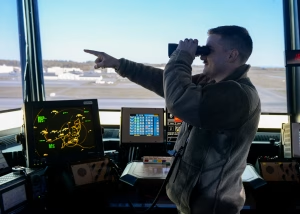Cleared for Modernization: The Top Avionics Upgrade for Fixing America’s Broken ATC

 As commercial air traffic surges back to pre-pandemic levels—and in many regions, surpasses them—aviation’s longstanding Achilles’ heel has returned to center stage: a strained, outdated Air Traffic Control (ATC) system ill-equipped to handle modern traffic volumes.
As commercial air traffic surges back to pre-pandemic levels—and in many regions, surpasses them—aviation’s longstanding Achilles’ heel has returned to center stage: a strained, outdated Air Traffic Control (ATC) system ill-equipped to handle modern traffic volumes.
From chronic delays and inefficiencies to rising fuel costs and CO₂ emissions, the consequences are piling up. But a long-planned, urgently needed avionics upgrade is finally moving from paper to cockpit: ADS-B In.
If ADS-B Out was the foundation, ADS-B In is the future.
While most aircraft flying today are already equipped with ADS-B Out—which broadcasts an aircraft’s position, velocity, and other data to ground stations and nearby aircraft—ADS-B In allows aircraft to receive and act on that same data. It effectively enables a real-time traffic picture in the cockpit, enabling pilots to “see” what ATC sees, often more precisely and sooner.
And in the current ATC crisis, that matters.
The ATC bottleneck…
The U.S. and much of Europe are operating ATC systems that haven’t fundamentally changed since the 1960s. Radar-based tracking is limited in range and accuracy. Controllers juggle dozens of aircraft with incomplete information and minimal automation. The result? Chronic congestion, especially in terminal areas, and an inability to flexibly reroute aircraft during weather events or sudden demand spikes.
Even the FAA’s ambitious NextGen modernization program, launched in 2007, has been slowed by politics, budget constraints, and the enormous technical lift of replacing decades-old infrastructure. But within this broader effort, ADS-B (Automatic Dependent Surveillance–Broadcast) is one area where progress is not only visible—it’s finally airborne.
ADS-B Out has already transformed surveillance by shifting from radar to satellite-based positioning. But its benefits are mostly to the system, providing ATC with more precise data. ADS-B In brings those benefits directly into the cockpit. Aircraft equipped with it can receive:
- Traffic Information Service–Broadcast (TIS-B): Real-time data about nearby aircraft, including non-ADS-B equipped planes tracked by radar.
- Flight Information Service–Broadcast (FIS-B): Weather updates, NOTAMs, and other situational awareness tools.
- Direct-to-aircraft data sharing: Letting pilots maintain optimal spacing and sequencing in terminal areas without waiting for ATC instructions.
ADS-B In enables airborne self-separation, in-trail spacing, and real-time rerouting, all vital in congested airspace.
Several airlines, including Delta and American, are actively retrofitting their fleets with ADS-B In capability. Airbus and Boeing are offering it as a line-fit option on new jets, especially for aircraft expected to operate in saturated airspaces like the U.S. East Coast, Western Europe, or over oceanic corridors where radar isn’t available.
The FAA has also begun testing Interval Management (IM) procedures, which use ADS-B In to allow aircraft to safely fly closer together, improving runway throughput and en-route capacity. Early trials at Dallas–Fort Worth and Atlanta show time savings of up to 10% during peak operations.
Avionics vendors step up…
Avionics giants like Honeywell, Collins Aerospace, Garmin, and Thales are racing to roll out certified ADS-B In packages that integrate with existing FMS and EFIS displays. These upgrades are being marketed not just as compliance tools but as fuel-saving, time-saving operational enhancements with immediate ROI.
The cost to retrofit a single narrowbody aircraft can range from $80,000 to $150,000 depending on configuration, but with rising fuel prices and stricter emissions targets, airlines are starting to see these upgrades not as expenses, but as essential investments.
The post Cleared for Modernization: The Top Avionics Upgrade for Fixing America’s Broken ATC appeared first on Avionics International.
—————
Boost Internet Speed–
Free Business Hosting–
Free Email Account–
Dropcatch–
Free Secure Email–
Secure Email–
Cheap VOIP Calls–
Free Hosting–
Boost Inflight Wifi–
Premium Domains–
Free Domains



















